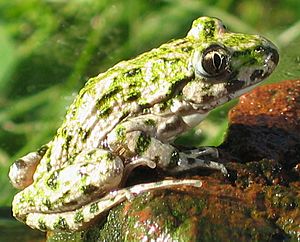Common parsley frog facts for kids
Quick facts for kids Common parsley frog |
|
|---|---|
 |
|
| Conservation status | |
| Scientific classification | |
| Genus: |
Pelodytes
|
| Species: |
punctatus
|
 |
|
The common parsley frog (Pelodytes punctatus) is a small frog found in southwestern Europe. It lives in the Iberian Peninsula (Spain and Portugal) and parts of France and Italy. Scientists first identified this frog in 1802.
Contents
What Does the Parsley Frog Look Like?
The common parsley frog is a small, thin frog with long back legs. It has a flat head and eyes with vertical pupils, like a cat's. Males are usually about 3.5 cm (1.4 in) long, while females are a bit bigger at 3.9 cm (1.5 in).
Its skin color varies, often with green patches on a light brown, grey, or olive background. Its back has small bumps, sometimes in wavy lines. These bumps can even be orange on its sides! The frog's belly is white and yellow-orange near its pelvis.
Special Features of the Parsley Frog
Parsley frogs are known as "Mud-Jumpers" because they can leap 50–70 cm (20–28 in) in one jump! They are also fossorial, which means they are good at digging and can live underground. Their limbs are specially made for burying themselves.
During mating season, male frogs grow dark bumps on their fingers, forearms, and chest. Their front legs also become stronger than the females'. Even though they are camouflaged, they are not completely hidden like some other frogs.
Where Do Parsley Frogs Live?
These frogs live in France, northeastern Spain, and a small part of northwestern Italy. Sadly, their numbers are decreasing in many areas. This is because their breeding spots are changing or disappearing. They are especially at risk in southern Spain and northern Portugal.
Parsley Frog Homes
Parsley frogs can live from sea level up to mountains as high as 1,630-2,000 meters (5,350-6,560 feet). However, they prefer to breed at lower elevations, usually around 60–460 meters (200-1,500 feet) above sea level.
Their habits change depending on the weather. Because they live in many different places, parsley frogs in one area might breed at different times than frogs of the same species living somewhere else with different weather.
How Do Parsley Frogs Behave?
Mating and Breeding Habits
Common parsley frogs can breed twice a year: once in the autumn and once in the spring. This helps them have more babies and adapt better to their environment. Interestingly, the ponds where they lay eggs are not always where they live as adults.
- In France, they breed from late February to early April.
- In Portugal, it's from November to March.
- In Andalusia, Spain, they might lay eggs several times a year.
Parsley frogs usually lay their eggs after heavy rainfall. If there's a long dry period, they can wait up to two months before breeding. They often choose temporary ponds with lots of plants underwater for their breeding sites. They prefer larger ponds and lay their eggs in a zig-zag pattern. A female can lay anywhere from 30 to 400 eggs!
Autumn-hatched tadpoles often do better than spring-hatched ones. This might be because they have more time to grow during winter, face less competition, and have fewer predators.
Tadpole Life and Changes
Young parsley frogs (tadpoles) can change their bodies to fit their environment. For example, in shallower ponds that dry up faster, tadpoles might have a shorter larval period. This means they grow up quicker. Tadpoles in deeper ponds tend to be larger. These changes help them survive, but they don't affect their overall survival rate.
Adult Frog Behavior
Adult parsley frogs are strong jumpers. Male frogs often stay in the same shelters when they are not breeding. They might even return to the same spots for several years. Females live near males and find them when they are ready to mate.
Parsley frogs usually hibernate (sleep through winter) for shorter periods than other frogs. Some frogs in warmer southern areas don't hibernate at all.
How Parsley Frogs Communicate
Male parsley frogs make a quiet croaking noise underwater using special sacs in their throats. Female frogs might answer with a "kee, kee" sound.
Their calls can change based on where they live, their size, or the temperature. A human more than 300 meters (980 feet) away usually can't hear their quiet calls. Calls typically last about 1.5 to 3 seconds. Larger frogs usually make longer, lower-pitched calls. Warmer temperatures make their calls quicker.
Protecting the Parsley Frog
Scientists used to be more worried about the common parsley frog's survival. But now, they believe it's at low risk of extinction. However, there are still challenges.
Threats to Parsley Frogs
One big problem is invasive species like fish and crayfish. These new predators eat parsley frog tadpoles, which lowers the frog's numbers. For example, the American red swamp crayfish and the Eastern mosquitofish have caused problems for parsley frogs in the Iberian Peninsula. It took only 30 years for the frogs to show physical changes after these crayfish arrived!
Parsley frogs are good at adapting, but their habitats are changing. Many ponds where their larvae live are drying up. This can happen because of human activities like draining wetlands or construction. Fires also threaten their homes. Because parsley frogs can adapt well, they might be able to move into new ecosystems even as the climate changes.
Legal Protection
The parsley frog is not critically endangered, but it is protected by law in Europe. Several laws protect this frog in France, Italy, and other regions. Because their breeding grounds are often temporary, conservation efforts need to be broad and cover many areas.


